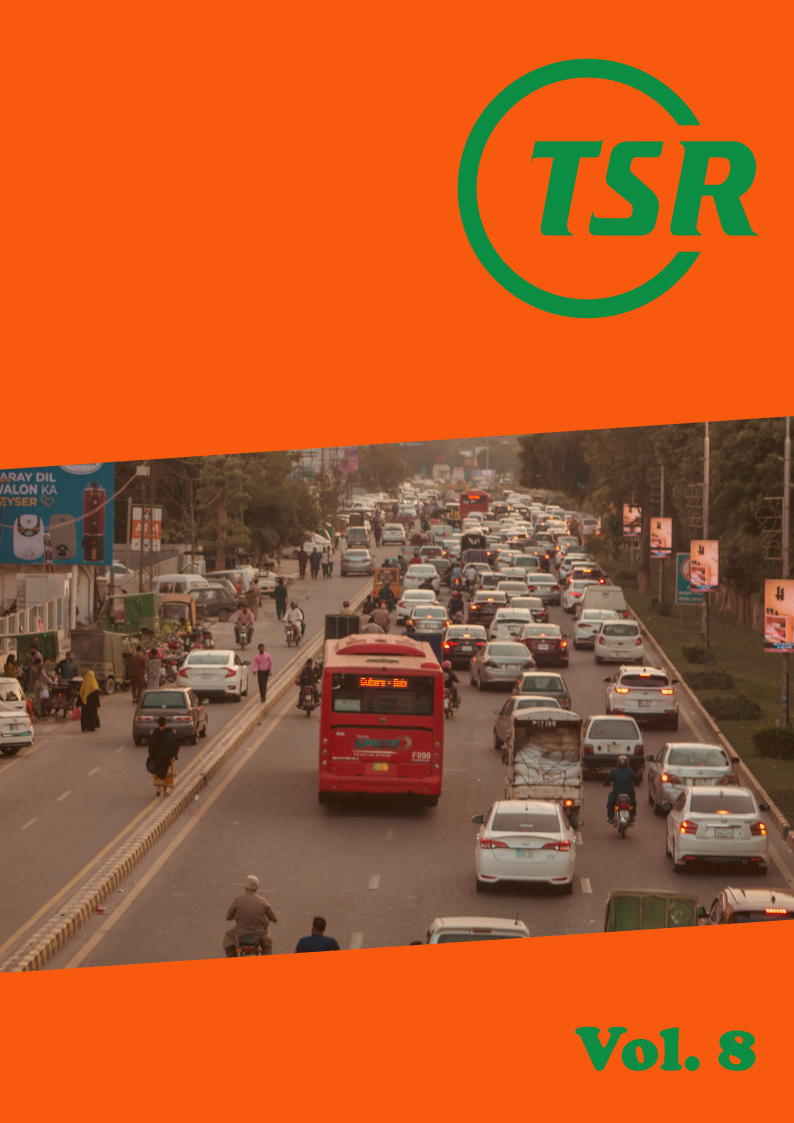Assessing the Ghanaian driver's susceptibility to distraction engagement
DOI:
https://doi.org/10.55329/aodw5139Keywords:
driver distraction engagement, driver type, driving context, Ghana, Susceptibility to Driver Distraction Questionnaire (SDDQ)Abstract
Driving requires managing multiple tasks in a dynamic environment. Yet, drivers frequently engage in non-driving activities, such as using mobile phones or adjusting in-vehicle technology, which distracts from essential vehicle controls. Evidence shows that such distractions impair performance and increase the risk of crashes and critical incidents. Understanding why drivers become distracted and identifying factors that contribute to distraction is crucial for developing effective interventions. This study examined the forms, instances, and predictors of distraction among Ghanaian drivers to propose actionable solutions. A sample of 257 private and commercial/professional drivers were recruited via personal contacts and social media and at bus terminals. The study examined voluntary and involuntary distractions using the Susceptibility to Driver Distraction Questionnaire (SDDQ) and four driving scenarios. Bivariate correlation and independent samples t-tests were used to assess relationships and differences among driver types, while hierarchical multiple regression identified key predictors of distraction. Results showed a positive correlation between self-reported distraction and voluntary distractions, with a negative correlation for involuntary distractions. Significant differences were found in the likelihood of mobile phone use between driver types in various driving contexts. Additionally, gender, age, past mobile-phone-related crash experiences, driving context (urban or motorway), attitude, injunctive norms, and involuntary distraction were significant predictors of distraction. These findings confirm the utility of the SDDQ in predicting distraction and emphasise the need for context-specific information when studying distraction.
Downloads
References
Ajzen, I. (1991). The theory of planned behaviour. Organisational Behaviour and Human Decision Processes, 50, 179–211. DOI: https://doi.org/10.1016/0749-5978(91)90020-T
Alketbi, L. M. B., Grivna, M., & Al Dhaheri, S. (2020). Risky driving behaviour in Abu Dhabi, United Arab Emirates: A cross-sectional, survey-based study. BMC Public Health, 20(1). DOI: https://doi.org/10.1186/s12889-020-09389-8
Bates, L., Anderson, L., Rodwell, D., & Blais, E. (2020). A qualitative study of young drivers and deterrence based road policing. Transportation Research Part F: Traffic Psychology and Behaviour, 71, 110–118. DOI: https://doi.org/10.1016/j.trf.2020.04.003
Bates, L., Soole, D., & Watson, B. (2012). The effectiveness of traffic policing in reducing traffic crashes. In T. Prenzler (Ed.), Policing and security in practice: Challenges and achievements (pp. 90–109). Palgrave Macmillan. DOI: https://doi.org/10.1057/9781137007780_6
Brown, I. (1986). Functional requirements of driving. Berelius Symposium on Cars and Casualties.
Burgel, B. J., & Elshatarat, R. A. (2019). Associations between daily-on-the job hassles with perceived mental exertion and depression symptoms in taxi drivers. American Journal of Industrial Medicine, 62(9), 791–802. DOI: https://doi.org/10.1002/ajim.23019
Chen, H. Y. W., Donmez, B., Hoekstra-Atwood, L., & Marulanda, S. (2016). Self-reported engagement in driver distraction: An application of the Theory of Planned Behaviour. Transportation Research Part F: Traffic Psychology and Behaviour, 38, 151–163. DOI: https://doi.org/10.1016/j.trf.2016.02.003
Chu, P., Yu, Y., Yang, J., & Huang, C. (2022). Understanding the mechanism behind young drivers’ distracted driving behaviour based on S-O-R theory. Journal of Transportation Safety and Security, 14(10). DOI: https://doi.org/10.1080/19439962.2021.1951912
Donkor, I., Gyedu, A., Edusei, A. K., Ebel, B. E., & Donkor, P. (2018). Mobile phone use among commercial drivers in Ghana: An important threat to road safety. Ghana Med J, 52(3), 122–126. DOI: https://doi.org/10.4314/gmj.v52i3.3
Dotse, J., Nicolson, R., & Rowe, R. (2019). Behavioural influences on driver crash risks in Ghana: A qualitative study of commercial passenger drivers. Traffic Injury Prevention, 20(2), 134–139. DOI: https://doi.org/10.1080/15389588.2018.1556792
Feng, J., Marulanda, S., & Donmez, B. (2014). Susceptibility to Driver Distraction Question-naire. Transportation Research Record: Journal of the Transportation Research Board, 2434(1), 26–34. DOI: https://doi.org/10.3141/2434-04
García-Herrero, S., Febres, J. D., Boulagouas, W., Gutiérrez, J. M., Ángel, M., Saldaña, M., Desapriya, E., & Okamura, K. (2021). Assessment of the Influence of Technology-Based Dis-tracted Driving on Drivers’ Infractions and Their Subsequent Impact on Traffic Accidents Se-verity. Int. J. Environ. Res. Public Health. DOI: https://doi.org/10.3390/ijerph18137155
Gordon, C. P. (2008). Crash studies of driver distraction. In M. A. Regan, J. D. Lee, & K. L. Young (Eds.), Driver distraction: Theory, effects and mitigation (pp. 281–304). CRC Press. DOI: https://doi.org/10.1201/9781420007497.ch16
Hasan, A. S., Orvin, M. M., Jalayer, M., Heitmann, E., & Weiss, J. (2022). Analysis of distracted driving crashes in New Jersey using mixed logit model. Journal of Safety Research, 81. DOI: https://doi.org/10.1016/j.jsr.2022.02.008
Karl, J. B., Nyce, C. M., Powell, L., & Zhuang, B. (2023). How risky is distracted driving? Journal of Risk and Uncertainty, 66(3). DOI: https://doi.org/10.1007/s11166-023-09405-3
Klauer, S. G., Dingus, T. A., Neale, V. L., Sudweeks, J. D., & Ramsey, D. J. (2006). The impact of driver inattention on near-crash/crash risk: An analysis using the 100-car naturalistic driving study data. DOI: https://doi.org/10.1037/e729262011-001
Lee, J. D. (2014). Dynamics of Driver Distraction: The process of engaging and disengaging. Annals of Advances in Automotive Medicine, 58, 24.
Lee, J. D., Young, K. L., & Regan, M. A. (2008). Defining driver distraction. In Driver distraction: Theory, effects, and mitigation (pp. 31–40). CRC Press. DOI: https://doi.org/10.1201/9781420007497.ch3
Lin, P. W., & Hsu, C. M. (2022). Innovative Framework for Distracted-Driving Alert System Based on Deep Learning. IEEE Access, 10. DOI: https://doi.org/10.1109/ACCESS.2022.3186674
Lyon, C., Brown, S., Vanlaar, W., & Robertson, R. (2021). Prevalence and trends of distracted driving in Canada. Journal of Safety Research, 76, 118–126. DOI: https://doi.org/10.1016/j.jsr.2020.12.005
Marulanda, S., Chen, H.-Y. W., & Donmez, B. (2015). Capturing voluntary, involuntary, and habitual components of driver distraction in a self-reported questionnaire. Eighth International Driving Symposium on Human Factors in Driver Assessment, Training and Vehicle Design, 1, 352–358. DOI: https://doi.org/10.17077/drivingassessment.1594
Mesic, A., Damsere-Derry, J., Gyedu, A., Mock, C., Larley, J., Opoku, I., Wuaku, D. H., Kitali, A., Osei-Ampofo, M., Donkor, P., & Stewart, B. (2023). Generating consensus on road safety issues and priorities in Ghana: A modified Delphi approach. Injury. DOI: https://doi.org/10.2139/ssrn.4329859
National Road Safety Authority. (2024). Road traffic crashes in Ghana statistics 2022.
Nicolls, M., Truelove, V., & Stefanidis, K. B. (2022). The impact of descriptive and injunctive norms on engagement in mobile phone use while driving in young drivers: A systematic review. Accident Analysis & Prevention, 175, 106774. DOI: https://doi.org/10.1016/j.aap.2022.106774
Olson, R. L., Hanowski, R. J., Hickman, J. S., J., B., & Safety, V. T. T. Institute. C. for T. and B. (2009). Driver Distraction in Commercial Vehicle Operations. DOI: https://doi.org/10.1037/e622372011-001
Oviedo-trespalacios, O., Haque, M., King, M., & Washington, S. (2018). Should I text or call here? A situation-based analysis of drivers’ perceived likelihood of engaging in mobile phone multitasking. Risk Analysis, 0(0). DOI: https://doi.org/10.1111/risa.13119
Pickering, C. A., Bumnhamt, K. J., & Richardson, M. J. (2007). A review of automotive human machine interface technologies and techniques to reduce driver distraction. DOI: https://doi.org/10.1049/cp:20070468
Prat, F., Gras, M. E., Planes, M., González-Iglesias, B., & Sullman, M. J. M. (2015). Psychological predictors of texting while driving among university students. Transportation Research Part F: Traffic Psychology and Behaviour, 34, 76–85. DOI: https://doi.org/10.1016/j.trf.2015.07.023
Razzaghi, A., Afshari, A., Shahsavarinia, K., Yazdani, M., & Nouri, A. (2024). Distraction and related risk factors among professional and non-professional drivers. DOI: https://doi.org/10.1016/j.heliyon.2024.e31530
Regan, M. A. (2010). Driven by distraction. Vision Zero International, 4–11.
Regan, M. A., & Hallett, C. (2011). Driver Distraction: Definition, Mechanisms, Effects, and Mitigation. In Handbook of Traffic Psychology (pp. 275–286). DOI: https://doi.org/10.1016/B978-0-12-381984-0.10020-7
Regan, M. A., Hallett, C., & Gordon, C. P. (2011). Driver distraction and driver inattention: Definition, relationship and taxonomy. Accident Analysis and Prevention, 43, 1771–1781. DOI: https://doi.org/10.1016/j.aap.2011.04.008
Regan, M. A., & Oviedo-Trespalacios, O. (2022). Driver Distraction: Mechanisms, evidence, prevention, and mitigation. In The vision zero handbook (Vol. 1, pp. 1–62). DOI: https://doi.org/10.1007/978-3-030-23176-7_38-1
Sajid Hasan, A., Patel, D., Alfaris, R., & Jalayer, M. (2022). Identifying distracted-driving events from on-road observations using a moving vehicle: A case study in New Jersey. Accident Analysis and Prevention, 177. DOI: https://doi.org/10.1016/j.aap.2022.106827
Sam, E. F. (2022a). How effective is police road presence and enforcement in a developing country context? Humanities & Social Sciences Communications, 9(55), 1–11. DOI: https://doi.org/10.1057/s41599-022-01071-1
Sam, E. F. (2022b). On the intention to cycle for work and school trips in a developing country. Geo: Geography and Environment, 9(1), 1–13. DOI: https://doi.org/10.1002/geo2.108
Sam, E. F., Odame, P. K., & Amoah-Nuamah, J. (2023). Predictors of distractive activities to walking in Accra, Ghana. Urban, Planning and Transport Research, 11(1). DOI: https://doi.org/10.1080/21650020.2023.2220574
Sutanto, K., Widyanti, A., Pratama, G. B., & Soetisna, H. R. (2022a). Technology for reducing distracted driving in developing countries: the level of usage and intention to use in Indonesia. Heliyon, 8(11), e11709.
Sutanto, K., Widyanti, A., Pratama, G. B., & Soetisna, H. R. (2022b). Technology for reducing distracted driving in developing countries: the level of usage and intention to use in Indonesia. Heliyon, 8(11). DOI: https://doi.org/10.1016/j.heliyon.2022.e11709
Tengma, E. (2024, July 22). Road traffic accidents: Over 1,200 deaths recorded between January and June this year. 3news.
World Health Organization. (2011). Mobile phone use: A growing problem of driver distraction. World Health Organization.
Wu, P., Song, L., & Meng, X. (2022). Temporal analysis of cellphone-use-involved crash injury severities: Calling for preventing cellphone-use-involved distracted driving. Accident Analysis and Prevention, 169. DOI: https://doi.org/10.1016/j.aap.2022.106625
Xing, L., Zhong, S., Yan, X., Wu, W., & Tang, Y. (2023). A temporal analysis of crash injury severities in multivehicle crashes involving distracted and non-distracted driving on tollways. Accident Analysis and Prevention, 184. DOI: https://doi.org/10.1016/j.aap.2023.107008
Published
Versions
- 2025-10-11 (2)
- 2025-06-04 (1)
How to Cite
Issue
Section
License
Copyright (c) 2025 Enoch F. Sam

This work is licensed under a Creative Commons Attribution 4.0 International License.








